Effective Techniques for Cleaning Couch Cushions
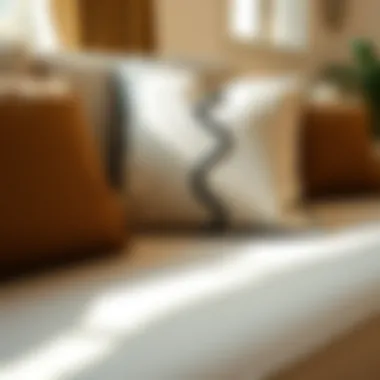
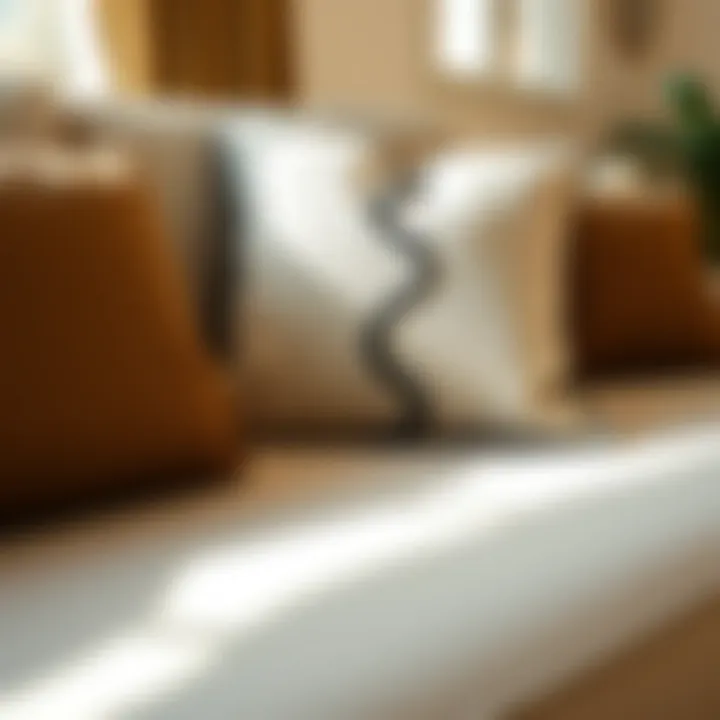
Intro
Couch cushions are more than just a comfy spot for lounging or a prop for your back during movie marathons. They are an essential part of a living space, contributing to both the comfort and aesthetic appeal of your home. Over time, cushions can gather dirt, stains, and allergens, impacting not just their appearance but also the hygiene of your living environment.
Understanding how to properly care for couch cushions can prolong their lifespan and maintain the overall look of your furniture. Whether your cushions are upholstered in leather, microfiber, or traditional fabrics, each material requires its own cleaning approach.
In this guide, we’ll delve into effective strategies for cleaning your couch cushions, addressing various fabric types and common stains. The focus will not only be on routine cleaning, but also on methods for tackling those pesky stubborn stains that seem to cling on for dear life.
By the end of this article, you’ll be equipped with the knowledge you need to restore your couch cushions to their former glory, ensuring they remain both aesthetically pleasing and hygienic. So, gather your supplies, roll up your sleeves, and let’s dive into the world of couch cushion care!
Home Features
Couches serve as the heart of living spaces, and selecting the right features can elevate their purpose and function.
Architectural Marvels
The depth and structure of your couch can significantly influence both comfort and style. A sectional sofa with fitted cushions, for instance, encourages convivial gatherings. Meanwhile, a classic three-seater with removable cushions can present a more traditional look, allowing for easy access during cleaning.
Unique Design Elements
Consider the fabric used on your cushions. Natural textiles like cotton or wool bring an elemental charm but may require more upkeep than synthetic materials. Additionally, bold patterns and colors can disguise lighter stains but may necessitate more frequent washing to keep them looking their best.
Interior Design Inspirations
Maintaining your couch cushions isn’t just about cleaning; it’s about integrating them into your overall home design.
Color Palettes and Themes
Pairing your sofa with complementary hues can enhance its visual impact. For instance, a muted palette might provide a calming effect, whereas vibrant cushions might inject energy into a space. The right color choice impacts not just design aesthetics but also the frequency with which you need to clean your cushions to keep those hues bright.
Furniture Arrangement Tips
Strategically arranging your furniture can protect your couch cushions from unnecessary wear. An optimal layout can minimize traffic over your couch, reducing the likelihood of stains and prolonging fabric life. Consider minimizing direct sunlight exposure to prevent fading and deterioration over time as well.
Your couch cushions are a vital component of your home’s beauty and comfort. Understanding how to maintain their appearance and hygiene will not only enhance your living space but also ensure that you can continue to enjoy their comfort for years to come.
Understanding Couch Cushion Fabrics
Selecting the appropriate fabric for couch cushions can significantly influence both cleaning methods and overall longevity. It's essential to understand various fabric types and their unique characteristics. Choosing the right fabric not only affects maintenance but also impacts comfort and aesthetics. Whether you’re dealing with stains from pets, kids, or everyday use, knowing your fabric is half the battle.
Common Fabric Types
Microfiber
Microfiber is a synthetic fabric made from polyester and nylon. One of its key characteristics is the tightly woven fibers that give it a soft touch while being durable. Because of this, microfiber is a popular option for couch cushions. It resists water and stains remarkably well, making it ideal for families and pet owners. Its unique feature of being easy to clean means that many common stains can be wiped away with just water. However, on the flip side, it can attract dust and may require occasional deep cleaning to maintain its look.
Leather
Leather brings a sense of luxury to any living room. This natural material is known for its durability and timeless style. The key characteristic of leather is its ability to develop a beautiful patina over time, enhancing its appearance rather than detracting from it. A major advantage is its resistance to stains and odors, as spills can typically be wiped away quickly. However, leather can be sensitive to scratches and requires special care products to maintain its look, which might not suit everyone’s upkeep routine.
Velvet
Velvet cushions can add a plush richness to your space, making them a favorite choice among design aficionados. This fabric has a unique depth and sheen that catches the eye. Velvet is soft and ideally suited for formal settings or cozy nooks. Its downside is its tendency to attract pet hair and dust, requiring regular vacuuming and occasional deeper cleaning. Furthermore, it can be more challenging to clean compared to more robust fabrics.
Canvas
Canvas is a heavy-duty fabric made from cotton or linen. Known for its ruggedness, it’s often used in outdoor settings, providing an excellent option for patio cushions or casual indoor use. The fabric is easy to clean and can often be machine washed, which is a significant advantage. Additionally, canvas is highly breathable, making it comfortable in warm weather. However, it can fade easily in direct sunlight, requiring care when placed near windows or outdoor areas.
Identifying Fiber Content
Understanding the fiber content of your couch cushions is key to applying the right cleaning techniques. Whether it’s through label inspection or using fabric swatches, knowing what you're dealing with can save headaches down the line.
Label Inspection
The first step in identifying fiber content is to check the label on your cushions. This label typically provides vital information regarding the type of fabric used, care instructions, and sometimes, cleaning recommendations. The key benefit of label inspection is that it helps to avoid using incorrect cleaning methods that could ruin your fabric. Moreover, it offers peace of mind when you know exactly how to treat your upholstery. However, labels can sometimes be unclear or missing altogether, which adds a layer of challenge to the process.
Fabric Swatches
If labeling is absent, fabric swatches can be a valuable resource. These samples allow homeowners to analyze the texture and durability of various fabrics. Swatching is beneficial in that it provides an accurate feel of the fabric, aiding in discerning cleaning needs based on its composition. The unique aspect of fabric swatches lies in their ability to give you insights into how the fabric interacts with cleaning solutions. However, swatches may not always be readily available and require effort to obtain.
Preparation for Cleaning
Before diving into the actual cleaning process, it’s crucial to undertake some necessary preparations. This phase sets the tone for an efficient cleaning experience, ensuring that you have all the right tools at hand and that you create an environment conducive to effective cleaning. Taking the time to prepare not only enhances your efficiency but also prevents potential mishaps that can occur if you're caught off guard during cleanup.
The importance of preparing for cleaning can't be overstressed; it allows you to avoid running back and forth looking for supplies. This is especially beneficial if you’re dealing with a large stain that requires immediate attention or if accidents happen during family gatherings. Furthermore, understanding how to approach the cleaning of your couch cushions according to their fabric type is essential. Different materials respond uniquely to cleaning agents, and having knowledge about those nuances contributes to the overall success of the maintenance process.
Gathering Necessary Supplies
To set yourself up for success, you should gather necessary supplies before you begin cleaning your couch cushions. This might sound like a no-brainer, but it makes all the difference. Let’s break it down into the essentials:
Vacuum Cleaner
A good vacuum cleaner is your best ally in the preparation stage. This tool is vital as it helps remove loose dirt, dust, and pet hair that can embed themselves into the cushion fibers. The key characteristic of a vacuum cleaner is its suction capability; a powerful vacuum cleaner can make short work of debris that is often saved for a thorough clean.
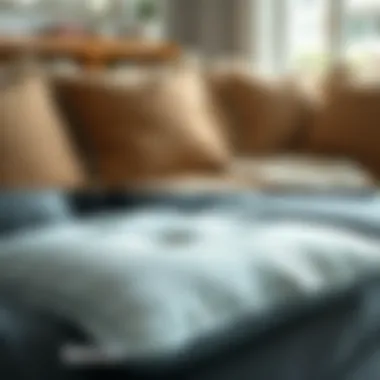
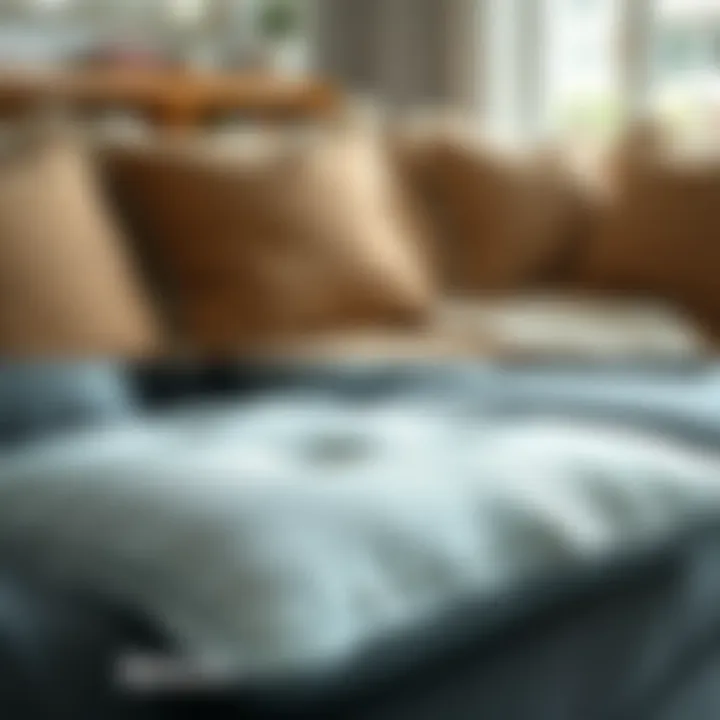
Among various types, upright vacuum cleaners are popular for home use due to their versatility and efficiency. Not only do they have the capacity to suction more significant amounts of dirt, but many come with attachments specifically designed for upholstery, which is a stellar benefit for cleaning your couch cushions. However, be wary; not all vacuum cleaners are created equal. Weighing energy consumption and efficiency can help you choose wisely.
Cleaning Solutions
Selecting the right cleaning solutions is equally important. This could range from commercial upholstery cleaners to homemade solutions like vinegar and water. The standout characteristic of effective cleaning solutions is their ability to break down and remove stains without compromising the fabric integrity.
Commercial solutions often come with specific instructions tailored for various fabrics, which can save you a lot of hassle. However, it’s critical to test any solution in an inconspicuous area of the cushion first. If you're prone to allergens or prefer something more eco-friendly, create a natural cleaner using basic household items. The ease of use and wide accessibility of products makes cleaning straightforward but ensures caution; some solutions may not work on all fabric types.
Soft Cloths
Soft cloths are indispensable for most cleaning tasks, especially when spot cleaning. Unlike harsher materials, a soft cloth causes minimal friction, reducing the risk of damaging delicate fabrics. Their absorbency is a noteworthy trait, allowing for the effective blotting up of stains without spreading them.
Opting for microfiber cloths is often the smart choice; they can trap dust and grime more effectively than traditional cotton cloths. The uniqueness of soft cloths is their versatility—they can be used dampened or dry, depending on the cleaning technique you employ. However, draining them properly is essential to avoid saturating your cushions during cleaning.
Removing Loose Dirt and Debris
Once you’ve gathered your supplies, it’s time to roll up your sleeves and get to work on removing loose dirt and debris. This step is often overlooked but crucial in preparing your cushions for thorough cleaning.
Vacuuming Techniques
Utilizing proper vacuuming techniques can make a significant difference. Start by detaching any specialized attachments that are meant for upholstery to navigate around the contours of your cushions.
The key characteristic of effective vacuuming is the methodical approach. Make sure to hit all angles, running the vacuum nozzle along each seam and fold of the fabric. This technique ensures that even the most stubborn bits of dirt and pet hair are extracted. Enforce patience; thorough cleaning can take time but pays off when the detail shows on your finished cushions.
Yet, not all vacuuming techniques yield the same results; rushing can lead you to miss some spots, especially in crevices which could potentially harbor unwanted debris.
Brushing with a Soft Brush
Another helpful technique is brushing the cushions with a soft brush. This approach complements vacuuming by loosening dirt and grime that might be stuck in the fibers. The key feature of using a brush lies in its ability to reach into deeper fibers that vacuums can miss.
Using a soft-bristled brush, work the fabric gently in a circular motion. While brushing is effective at loosening debris, care is important; over-brushing can wear down the fabric or lead to pilling in certain materials. Thus, being gentle but effective strikes the right balance in your cleaning approach.
By properly preparing for cleaning and employing effective techniques to remove loose dirt and debris, you create a solid foundation for the following cleaning steps. Each phase works in tandem to ensure that your couch cushions not only look spotless but also withstand the daily wear and tear of household living.
Spot Cleaning Techniques
Spot cleaning is a vital technique within the realm of upholstery care. When mishaps occur—whether it's a spilled drink or an errant pet paw—knowing how to effectively tackle these stains can mean the difference between restoring your couch cushion to its former glory or letting an eyesore set in. Spot cleaning techniques focus on addressing specific stains right at the moment they happen, helping to maintain the overall appearance and cleanliness of your cushions. Here’s how to handle this often underappreciated facet of couch maintenance.
Dealing with Stains
Common Stains: Coffee, Wine, and Grease
Stains like coffee, wine, and grease are notoriously pesky, and they can leave lasting impressions that age your couch cushions prematurely. These stains often possess strong pigments or oily residues that can settle deep into fibers if left untreated.
- Coffee stains can darken fabric and often come with a distinct fragrance that can linger.
- Wine not only creates a visible mark but can also smell quite pungent if not cleaned promptly.
- Grease is another enemy; it tends to spread and can attract dirt.
Identifying these common stains early and acting swiftly is paramount. The key characteristic of these stains is their potential to set quickly. Treating stains while they are fresh ensures that they can be lifted more easily before they bond with the fabric.
In this article, we emphasize the importance of addressing these stains head-on using efficient spot cleaning methods. Not only does this enhance the couch’s aesthetic appeal, but it also promotes a healthier environment free from the buildup of bacteria or odors.
Applying Cleaning Solutions
When it comes to spot cleaning, knowing how to apply the right cleaning solutions is essential. It’s not solely about the solution itself, but how it’s used that can make or break the cleaning effort.
- Choosing the right cleaning agent is crucial. Misapplying a too-strong chemical might damage delicate fabrics, while a gentle soap may not tackle stubborn stains effectively.
- Techniques of application, such as using a soft cloth vs. a harsh scrub, can greatly impact the outcome in preserving the integrity of the cushion fabric.
The unique feature of applying cleaning solutions is the balance between effectiveness and fabric safety. Using the proper amount helps dissolve stains without oversaturating the fibers, which could lead to water stains or mold growth if the sponge or cloth used isn't adequately wrung out.
Blotting vs. Scrubbing
When to Blot
Knowing when to blot rather than scrub is one of the most important lessons in handling stains. Blotting is often more effective in absorbing liquid stains without pushing them deeper into the fibers. The central tenet here is, "Don’t rub it in; lift it out."
Blotting is beneficial because:
- It reduces the risk of spreading the stain further.
- It requires less aggressive cleaning solutions, which helps maintain fabric integrity.
Recognizing that some fabrics are more prone to damage can influence whether you opt for blotting. Heavy-duty fabrics can handle a bit of scrubbing, but plush types like velvet require a more sensitive approach.
The Risks of Scrubbing
While it might seem intuitive to scrub stains away, this technique carries its own risks. Scrubbing can actually distort and damage the fabric fibers, creating flaws and possibly even leading to pilling.
Here are some notable risks associated with scrubbing:
- Fabric damage from aggressive action can lead to worn spots that become apparent over time.
- Color distortion, especially in dyed or patterned fabrics, as scrubbing can cause uneven fading.
In short, knowing when to switch from blotting to scrubbing can be a game changer. In situations where a stain needs a little extra elbow grease, always approach it with caution and gentleness to enhance the cleaning process rather than hinder it.
In summary, mastering spot cleaning techniques—such as effectively dealing with common stains, applying solutions wisely, and understanding when to blot versus scrub—will greatly extend the life of your couch cushions. A little knowledge empowers owners to maintain their furniture in tip-top shape, ultimately fostering a more hygienic and inviting living space.
For additional resources on cleaning techniques, you may wish to check out sites like Wikipedia's Cleaning, Britannica, or forums on Reddit for more tips and tricks.


Deep Cleaning Methods
Deep cleaning couch cushions is a vital process that goes beyond simple vacuuming or spot cleaning. It reaches into the fibers of the fabric, tackling accumulated dirt, allergens, and odors that regular cleaning methods might miss. By employing deep cleaning methods, you extend the life of your sofa while significantly improving the health and hygiene of your living space. This section examines methods like steam cleaning and washing removable covers, both of which can rejuvenate your cushions.
Using a Steam Cleaner
Benefits of Steam Cleaning
Steam cleaning does wonders for couch cushions, offering a way to sanitize and revitalize fabric without the need for harsh chemicals. This method uses high-temperature steam to penetrate deep into the fibers, effectively breaking down dirt and grime. One of the standout features of steam cleaning is its ability to remove allergens like dust mites and pet dander, making it especially appealing for households with allergy sufferers. Additionally, the use of steam can kill bacteria and germs, contributing to a cleaner, healthier environment.
Moreover, steam cleaning is considered an environmentally-friendly cleaning solution, as it minimizes the use of detergents and chemicals. However, it is important to ensure that your fabric is suitable for steam cleaning, as some delicate materials may get damaged by heat and moisture.
Proper Techniques
When using a steam cleaner on couch cushions, following proper techniques can greatly enhance the effectiveness of your efforts. First, it's essential to vacuum the cushions thoroughly to remove surface debris before introducing steam. When applying steam, make sure to keep the nozzle a safe distance from the fabric to avoid scorching. Move the cleaner slowly and methodically across the surface to allow the steam to do its work.
In addition, it is wise to let the cushions dry completely after steaming. This decreases the chances of mold or mildew, which can thrive in damp conditions. Keep in mind that while steam cleaning has many advantages, improper use can lead to water damage or an unhealthy build-up of moisture inside the cushions.
Washing Removable Covers
Checking Care Labels
Care labels on removable cushion covers are not just there for decoration; they hold essential information about how to clean your cushions without causing damage. Understanding these labels helps you choose the right washing method, whether it be machine or hand washing. Labels may provide insights on water temperature, drying methods, and specific detergents that should or shouldn’t be used. Ignoring this critical step can result in shrinkage, discoloration, or even fabric breakdown.
Typically, the materials dictate the preferred cleaning method. For instance, polyester covers often withstand machine washing, while more delicate fabrics like silk or wool may demand hand washing. Always err on the side of caution by thoroughly inspecting the care label before proceeding with any washing.
Machine vs Hand Washing
The choice between machine and hand washing can significantly impact the cleanliness and lifespan of your couch cushions. Machine washing is convenient and often more effective for heavily soiled fabrics, especially when dealing with tougher stains or deeper dirt. The benefits include efficiency and the ability to use a variety of wash cycles tailored to fabric types.
On the other hand, hand washing provides a gentle touch, making it ideal for delicate fabrics that are prone to damage in a washing machine. This method allows for greater control over the cleaning process, ensuring that you can pay close attention to every corner of the cushion cover. However, it does require more time and effort compared to simply tossing them into the washer.
Ultimately, the decision between the two methods hinges on the type of fabric, the extent of the soiling, and your personal preferences. Whether machine or hand washing, the goal remains the same: restore freshness while ensuring the durability of your cushions.
Drying Techniques and Precautions
When it comes to keeping your couch cushions looking sharp and feeling fresh, how you dry them carries a significant weight. If you think about it, proper drying can mean the difference between cushions that last and those that simply sag and lose their appeal. It’s not just about getting the moisture out; it’s about preserving the fabric and the shape of your cushions.
Air Drying vs. Machine Drying
Benefits of Air Drying
Air drying is as simple as it sounds—letting nature do its thing. One of the standout qualities of this method is that it tends to be gentler on the fabrics. Unlike machine drying, where tumbling can lead to wear and tear, air drying allows cushions to retain their structure and softness. This is especially important for delicate fabrics like velvet or some synthetics, which might not take too kindly to high heat.
- Preservation of Fabric: Air drying helps maintain the integrity of the fabric.
- Moisture Management: This method also prevents overheating, which can create problems like shrinkage or stiffness.
Air drying does take longer, no doubt about it. But the upside—ensuring your couch cushions don’t lose their shape or comfort—makes it well worth the wait.
"The key to keeping your fabric looking like new is to treat it with the tender kind of love only nature can provide."
Risks of Machine Drying
Now, stepping into the world of machine drying might sound tempting, what with its speed and convenience. However, this technique has its downsides. The high temperatures and mechanical agitation of a dryer can wreak havoc on fabric fibers, leading to shrinkage or uneven textures.
- Heat Exposure: High heat can distort the shape of cushions, especially those with inner materials that can’t withstand it.
- Fibers on Edge: Some materials, such as certain linens and cottons, may fray or wear down faster when subjected to a dryer’s swirling motion.
In summary, while machine drying serves a purpose in a pinch, it’s crucial to be cognizant of the potential harm it may cause to the fabric and structure of your cushions.
Maintaining Shape
Maintaining the shape of your couch cushions is paramount to ensuring their longevity. Over time, cushions can flatten and lose their form, making your sofa appear worn and tired. Here are two practical strategies to keep your cushions looking fresh.
Fluffing Cushions
Fluffing cushions is as vital as it is simple. Doing this regularly encourages the fibers to regain their shape and firmness. Think of it as giving your cushions a gentle massage.
- Enhanced Comfort: By regularly fluffing your cushions, they not only look good but feel better too.
- Longevity: This process helps redistribute the filling, reducing the chances of denser areas developing, which can happen from prolonged sitting.
In a nutshell, this quick routine can extend the lifespan of your couch cushions significantly, keeping them plush and inviting.
Using Weight for Structure
Another technique worth mentioning is using weight to retain shape. This could involve placing books or even light furniture on compressed cushions for a brief period.
- Shape Retention: The added weight helps to mould the cushions back into their original shape after washing or heavy use.
- Practicality: This method doesn't require special tools or cleaning solutions, making it an easy fix.
While it might seem simple, the strategy of applying weight is effective for those who might not have the time for regular fluffing but still want to keep their couch in tip-top shape.
Regular Maintenance Tips
Maintaining couch cushions isn’t just about occasionally wiping them down; it’s an ongoing process that can significantly influence the life of your furniture. Regular maintenance helps in preventing the build-up of dirt and allergens that can lead to health issues and damage. Plus, a little upkeep goes a long way in keeping the cushions looking fresh and inviting.
Establishing a Cleaning Schedule
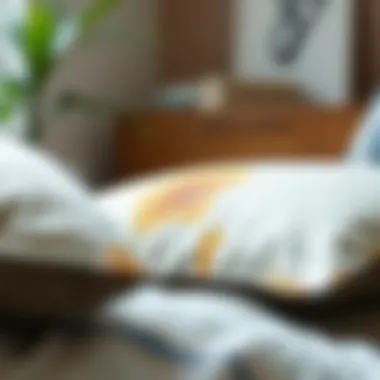
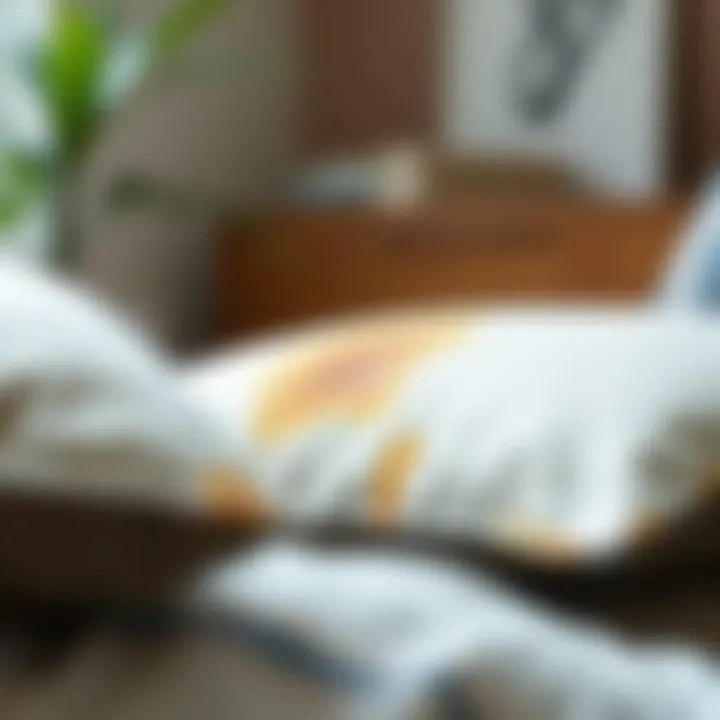
Frequency Recommendations
Creating a routine for how often to clean your couch cushions can make tasks feel less daunting. Generally, a weekly vacuum is recommended to catch crumbs and pet hair before they settle deeply. This small step can prevent allergens from accumulating, ensuring your living space remains safe and pleasant. The beautiful part about setting such a schedule is it can be adapted to your lifestyle. For families with kids or pets, more frequent cleaning may be necessary, while single adult households may benefit from a less rigorous approach. In essence, establishing a frequency not only keeps your cushions in good shape but it can also create a habit that eventually feels effortless.
Seasonal Deep Cleaning
Every few months, it's wise to take it a step further and embark on seasonal deep cleaning. This clean-up often means treating those cushions to a more thorough scrub down, eliminating stains and odors that daily cleaning might miss. A unique feature of seasonal cleaning is that it often coincides with changing weather conditions, making it a good time to inspect your cushions for any wear and tear caused by humidity or dryness.
Such cleaning can include washing removable covers or using a steam cleaner. The advantages of seasonal deep cleaning lie in the freshness it brings, eliminating built-up grime that slowly inflicts damage over time. In the end, although some might view it as a big chore, the payoff is a set of cushions that feel and look brand new.
Using Fabric Protectors
Types of Protectors
Incorporating fabric protectors into your cleaning regimen is an intelligent move many homeowners overlook. These protective sprays and treatments work wonders by creating a barrier against spills and stains. Different types of protectors are available, from water-based sprays to silicone-based coatings. Each has its benefits and drawbacks; for instance, water-based protectors may not offer the same longevity as their silicone counterparts but are often easier to apply and safer for sensitive fabrics.
The standout quality of fabric protectors is their preventive nature, ensuring that even if an accident happens, cleanup is much simpler. This layer of protection can extend the lifespan of your cushions significantly.
Easy Application Methods
Now, when it comes to applying fabric protectors, simplicity is key. Most protectors come in spray bottles, making application straightforward. Spraying in thin, even coats ensures you cover every inch while preventing buildup. A great practice is to do this work on a day you can allow the cushions to air out, ensuring that any fumes dissipate before usage.
Easy application methods not only streamline the chore but also encourage homeowners to keep up with preventative maintenance. As a bonus, many fabric protectors can be reapplied every 6-12 months, depending on wear, which means a simple refresh to keep those cushions looking sharp and new.
"Regular cleaning and maintenance is not just about preserving your couch; it's about cherishing your living space and the moments spent within it."
Addressing Odors and Allergens
Cleaning couch cushions goes beyond just removing dust and stains. It involves a critical aspect that often gets overlooked: addressing odors and allergens. When you sit on your couch or cuddle up for a movie night, the last thing you want is an off-putting smell or a sneeze from hidden allergens. Tackling these elements can greatly enhance not only the aesthetic of your seating area but also the air quality of your home.
Identifying Sources of Odor
Food, Pets, and Mildew
When it comes to odors, food, pets, and mildew can be the culprits that cause your sofa to smell less than fresh. For food, greasy fingerprints from popcorn or coffee spills can linger long after the treat is gone. Pets, too, leave their mark—think of fur, dander, and the odd accident that might go unnoticed until it’s too late. Mildew can creep up in humid environments, thriving where moisture exists, particularly in fabric cushions that absorb sweat or spills.
The key characteristic of food-related odors is their grease-based nature. They cling to fabric fibers and can be incredibly stubborn to remove unless treated promptly. Pets contribute their own unique set of smells that can create a lingering odor of wet dog or uncleaned litter. Moreover, mildew creates a musty smell that’s often hard to ignore and signals the presence of moisture that could be damaging.
In this context, understanding the sources of these odors is instrumental in devising a proper cleaning strategy. The presence of these elements may serve as both a nuisance and a reason for health concerns, including allergies and respiratory issues. While food odors can often be masked, pet odors and mildew might require more stringent cleaning strategies to eliminate.
The Impact of Humidity
Humidity is often more than just an inconvenience. It plays a significant role in developing odors within home textiles. High humidity levels can encourage mold and mildew to flourish, resulting in unpleasant smells and allergens that float through the air when someone settles onto the sofa.
The unique feature of humidity is its ability to exacerbate existing conditions within your cushions. Should your living space retain too much moisture, fabrics trap this moisture, providing an ideal environment for allergens such as dust mites and mold spores. Therefore, maintaining humidity levels in your home is not just about comfort; it’s about ensuring your couch—along with your wellbeing—stays odor-free and allergen-free.
Keeping a hygrometer handy can help you monitor humidity levels. Aim for a relative humidity of 30-50% indoors. If necessary, use a dehumidifier to regulate moisture levels, which in turn can significantly reduce any offensive odors.
Effective Odor Removal Methods
Baking Soda
Baking soda is a true powerhouse when it comes to tackling odors. This simple kitchen staple is not only effective but also a safe choice for fabrics. Its key characteristic lies in its ability to absorb unwanted smells rather than just masking them. By sprinkling baking soda over your couch cushions, letting it sit for several hours, and then vacuuming it up, you create a clean slate.
The unique feature of baking soda is its non-toxic nature, making it ideal for households with children and pets. It’s a beneficial aspect of the approach discussed in this article, as many cleaning agents can contain harsh chemicals. However, you should also be cautious; excessive use might leave a white residue that could require additional cleaning efforts.
Essential Oils
When it comes to adding a pleasant aroma to your couch cushions, essential oils stand out. Beyond their appealing scent, these oils can give off antimicrobial properties, which assists in combating bacteria that may reside in your cushions. Whether it's lavender for relaxation or tea tree oil for a clean feeling, the options are abundant.
Essential oils are popular not just because of their fragrance but also due to their versatility. You can mix them into water for a simple spray, infusing your fabric with a delightful scent while discouraging unwanted smells. However, be cautious—using essential oils in excess may lead to fabric stains or reactions. Always dilute properly and test in a small area first.
"The best part about using natural solutions is that they often come with fewer side effects compared to chemical cleaners, allowing for healthier living spaces."
By identifying the sources of odors and utilizing effective removal methods, you can maintain a fresh atmosphere in your home. Addressing these concerns not only supports the longevity of your couch cushions but also enhances the overall quality of your living environment, ensuring that it remains a welcoming space for family and friends.
Ending: Enhancing the Lifespan of Your Couch Cushions
When it comes to maintaining the comfort and visual appeal of your living space, couch cushions often play a vital role. They can be the cherry on top of your interior design or the stumbling block that drags down the overall ambiance. The methods discussed throughout this guide serve as essential tools for extending the life of your couch cushions while also ensuring they remain a healthy part of your home environment. Taking the time to clean them effectively can make all the difference—both in aesthetic value and the cushions’ longevity.
Caring for your couch cushions isn’t just about keeping them clean; it’s about preserving your investment and upholding the overall quality of your furniture. When cushions are well-maintained, they can resist wear and tear better over time. With the right practices in place, stains can be tackled promptly, and odors can be mitigated before they take root. In essence, a regular cleaning routine can transform your couch cushions from mere fabric-covered pieces into a centerpiece of comfort and style in your space.
Moreover, understanding the unique needs of different fabric types empowers you as a home caretaker. The nuances between microfiber, leather, velvet, and canvas all guide your cleaning choices and routines. Thus, recognizing these differences will hold you in good stead, particularly when spot cleaning or deep cleaning becomes necessary.
"A little preventive maintenance goes a long way."
Equipping yourself with knowledge about regular care, proactive protection, and dealing with common allergens and odors will turn an often-neglected aspect of home care into a simple, manageable task. Thus, enhancing your couch cushions will not just extend their lifespan but will also contribute positively to the overall environment of your home.
Summarizing Key Points
- Understanding Fabrics: Knowing your cushion fabrics helps to choose the right cleaning methods and products.
- Preparation is Key: Gathering necessary supplies and prepping the area ensures a smooth cleaning process.
- Regular Maintenance: Establishing a cleaning schedule can prevent dirt build-up and extend the life of your cushions.
- Spot Clean and Deep Clean: Differentiating between spot cleaning for small stains and deep cleaning for thorough care is essential for maintaining cushion health.
- Odor Management: Identifying sources of bad smells and addressing them can significantly improve the comfort level of your sofa.
By staying informed and proactive, you can significantly enhance the lifespan of your couch cushions, ensuring they remain a warm and welcoming part of your home for years to come.
Encouraging Proactive Care
Taking a proactive approach to caring for your couch cushions is akin to giving them a fighting chance. The simple act of applying fabric protectors or maintaining a consistent cleaning schedule can prevent future headaches. Rather than waiting until a stain sets in or an odor becomes overwhelming, you can take charge and set a precedent for cushion care in your household.
- Utilize Fabric Protectors: Investing in a quality fabric protector can act as a barrier against spills and stains, making everyday cleaning far less daunting. Simply follow the application guidelines and enjoy a new layer of defense on your upholstery.
- Frequent Inspections: Regularly check your cushions for signs of damage or dirt accumulation. Early detection means early action, which can save a lot of trouble down the road.
- Lifestyle Adjustments: Consider how you use your couch. If you have pets or kids, you might want to adapt your cleaning routine or choose fabrics that are durable and easy to clean.
Implementing these practices will not only result in cleaner cushions but it fosters a greater appreciation for your living space. Furthermore, a little foresight translates into long-term satisfaction, allowing you to enjoy your investment without constant worry. In an age where convenience often trumps care, taking the initiative to maintain your cushions could be one of the best decisions for your home.



